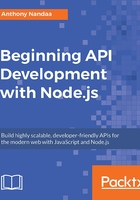
The Basics of Node.js
Node.js is an event-driven, server-side JavaScript environment. Node.js runs JS using the V8 engine developed by Google for use in their Chrome web browser. Leveraging V8 allows Node.js to provide a server-side runtime environment that compiles and executes JS at lightning speeds.
Node.js runs as a single-threaded process that acts upon callbacks and never blocks on the main thread, making it high-performing for web applications. A callback is basically a function that is passed to another function so that it can be called once that function is done. We will look into this in a later topic. This is known as the single-threaded event loop model. Other web technologies mainly follow the multithreaded request-response architecture.
The following diagram depicts the architecture of Node.js. As you can see, it's mostly C++ wrapped by a JavaScript layer. We will not go over the details of each component, since that is out of the scope of this chapter.

Node's goal is to offer an easy and safe way to build high-performance and scalable network applications in JavaScript.